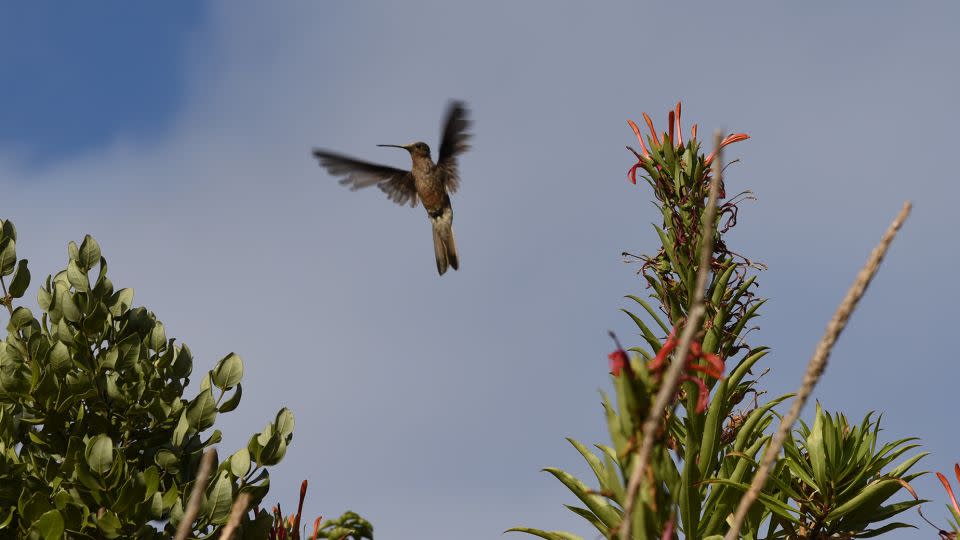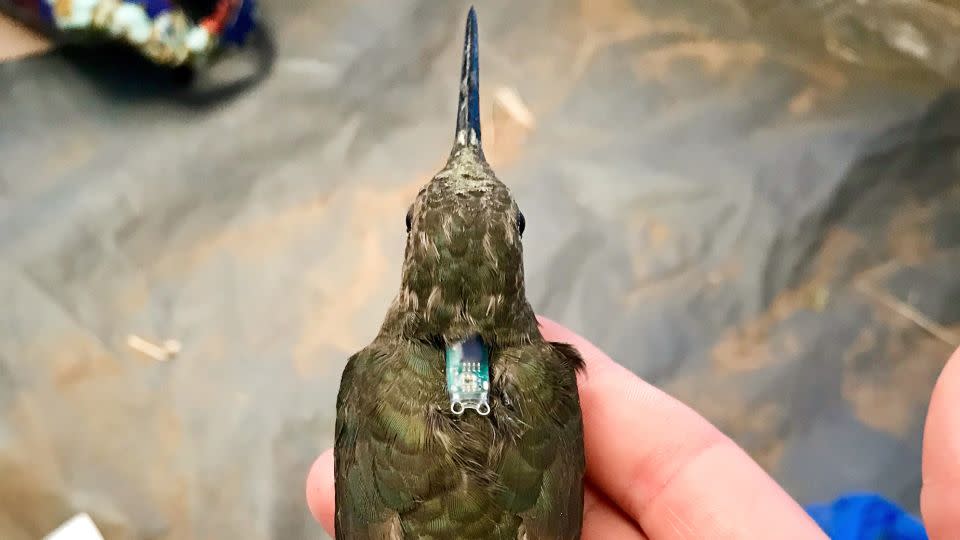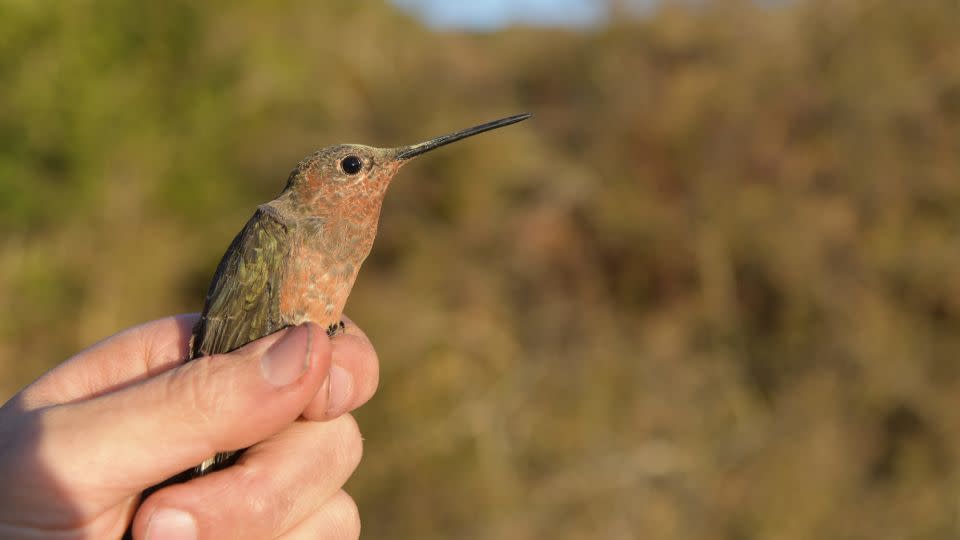Sign up for CNN’s Wonder Theory science newsletter. Explore the universe with news about fascinating discoveries, scientific breakthroughs and more.
The world’s largest hummingbird has been hiding in plain sight for centuries, and after scientists fitted hummingbirds with tiny backpacks to understand their migration patterns, they discovered that this species was different from other giant species.
Along the way, researchers also identified the longest hummingbird migration journey, which covers a round-trip journey of 5,200 miles (8,368 kilometers), or the distance between New York City and Buenos Aires.
Questions about South America’s giant hummingbird have persisted since naturalist Charles Darwin first observed them during his expedition aboard HMS Beagle in 1834.
Darwin observed that birds about eight times the size of typical hummingbirds bred on the Pacific coast of Chile, but disappeared completely after breeding. He speculated that giant hummingbirds migrated to the Atacama Desert region of northern Chile.
New research has revealed that two different species of giant hummingbird are found in South America: the northern giant hummingbird, which lives year-round in the Andes, and the migratory southern giant hummingbird. These have been evolving separately for millions of years.

A new study describing the birds was published Monday in the Proceedings of the National Academy of Sciences.
“There’s not a lot of animal migration of large, charismatic species that are still completely unknown, but that was the case for southern giant hummingbirds,” said lead study author Jessie Williamson, a National Science Foundation Postdoctoral Fellow and Rose Postdoctoral Fellow at Cornell. Laboratory of Ornithology in Ithaca, New York. “We wanted to finally solve this mystery.”
Designing backpacks for hummingbirds
Giant hummingbirds differ from hundreds of other hummingbird species in many ways.
“Everything about giants is abnormal; not only are they much larger (twice or more) than the second largest hummingbird, but their wing beats and heartbeats are also much slower,” Williamson said. said. “And their wings are proportionately longer, so they have a completely unique appearance in flight, almost like a swift soaring through the air.”
Swifts are medium-sized, fast-flying birds belonging to the family Apodidae, which also includes hummingbirds.
But regardless of their size, studying hummingbirds is a challenging task. During fieldwork, the team worked with local landowners and village residents in Peru and Chile.
“Capturing Giant Hummingbirds is very challenging,” said study co-author Emil Bautista, a researcher at the Centro de Ornitología y Biodiversidad in Lima. “They watch everything and know their area well. We had to be strategic when choosing locations for our networks. If Giant Hummingbirds see something unusual, they will not visit that spot. “They are more observant than other birds.”
Williamson said the research team spent nine months camping in rural parts of Chile and Peru, working from sea level to the steep, cactus-covered slopes of the Andes Mountains and going weeks without electricity or running water.
Williamson designed a backpack harness using a type of jewelry cable to attach a microtracking device to 57 hummingbirds in Chile.
“Designing suitable backpack harnesses for giant hummingbirds required two seasons of trial and error, including implementing the harness design on a stuffed hummingbird finger puppet… with a paper mock-up geolocation device, as well as tracking the little ones.” There was a lot of consultation with colleagues who have experience with migratory birds,” Williamson said.


Geolocator backpacks weighed 0.3 grams and were designed to be small and light enough to not hinder the birds’ flying style.
In June 2021, Williamson published a paper in the Journal of Avian Biology describing his design and how to securely attach it to hummingbirds.
“Hummingbirds are very difficult to work with because they are light and have long wings and short legs. They are nature’s little acrobats,” he said.
But catching the birds, attaching their backpacks and releasing them was not enough; The birds had to be recaptured before the team could collect the data.
Williamson said the researchers were able to retrieve data from eight geolocators by recapturing the birds using fine mesh nets called “mist nets” commonly used by ornithologists.
What the team discovered was that migratory southern giant hummingbirds resemble human climbers.
High altitude bird flights
Geolocator data revealed that migratory giant hummingbirds can reach altitudes as high as 3,962 meters above sea level, and their journeys bring them as far north as the Peruvian Andes.
However, birds do not fly directly to these high altitudes. Instead, like mountain climbers, they pause for days during the climb to allow their blood and lungs to adjust to lower oxygen levels.
By tracking the birds’ migration with geolocators and satellite transmitters, scientists have discovered what they believe is the longest known hummingbird migration, stretching 5,200 miles (8,368 kilometers) from the coast of Chile to the Andes Mountains in Peru.
When the researchers examined the birds and compared them with genetic data from museum specimens, they realized there were two species of giant hummingbirds.
“No one knew where the migratory giant hummingbirds were going because they were hiding among the non-migratory giant hummingbirds,” said senior study author Christopher Witt, professor of biology and director of the Southwestern Museum of Biology at the University of New Mexico. expression. “The two species of giant hummingbird look almost identical; for centuries ornithologists and birdwatchers never realized they were different. We wouldn’t have figured it out without miniature viewers.”
A change in migratory behavior likely caused the difference between the two species. By examining museum species, including a 154-year-old specimen, the researchers realized that the two species of giant hummingbirds had evolved separately for about 3 million years.
“They are as different from each other as chimpanzees are from bonobos,” Witt said. “The two species overlap in their high-elevation wintering grounds. It is mind-boggling that these two species have been separated for millions of years, even though no one has ever solved the mystery of the Giant Hummingbird.”
The northern giant hummingbird, which lives year-round in the high Andes, has a different lung and blood capacity compared to the southern giant hummingbird.
After realizing the two birds were completely different species, the study team named the northern giant hummingbird the Patagona chaski, a nod to chaskis, which means messengers in the Quecha language of the Inca Empire. Quecha is a group of indigenous languages used in Peru and neighboring countries.
“Chaski runners were sure-footed sprinters capable of speed and endurance on steep slopes, due in part to their high-capacity lungs and rigorous aerobic training at high altitude,” the authors wrote in the study.
New bird mysteries emerge
The researchers reported that both populations of giant hummingbirds were stable, and some could even be seen taking nectar from backyard feeders.


Now that two distinct species have been confirmed, the team wants to better understand how the populations interact when they live in the same areas of the Andes, especially during the winter months.
“We need to figure out where these two forms come together and how they interact,” Witt said. “Do they compete, do one dominate the other, how might they allocate resources, and do they mix or spatially separate during winter? There are lots of interesting questions to pursue!”
Williamson also wants to work with botanists to understand how bird migration patterns evolved along with the flowering plants that birds use to feed on during their journeys.
“I’m really interested in how Southern Giant Hummingbirds make such dramatic elevation changes during migration,” Williamson said. “They look like miniature mountain climbers. “How do they change their physiology to facilitate these movements?”
For more CNN news and newsletters, create an account at CNN.com